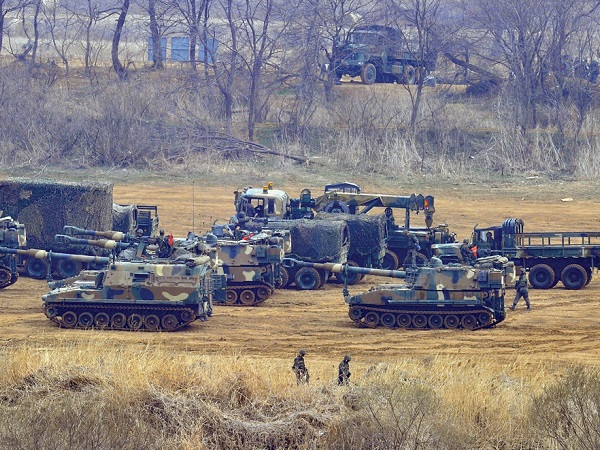NoKor missiles set to fire

SOUTH OF THE BORDER South Korean soldiers with K-55 self-propelled howitzers train near the border city of Paju as tensions soared with the North Korean threat of nuclear strikes on the South and US territories in the Pacific. The United States said it was taking all precautions against the North Korean threat. AFP
SEOUL—North Korea has moved a second midrange missile to its east coast and loaded it on a mobile launcher, a report said on Friday, fueling fears of an imminent firing that will further ramp up tensions in the Asia-Pacific region.
Yonhap news agency, citing a top South Korean official, said two intermediate Musudan missiles had been transported by train earlier in the week and “loaded on vehicles equipped with launch pads.”
South Korean Defense Minister Kim Kwan-jin said earlier that the first missile moved on Thursday could reach a “considerable range” but not the US mainland, telling lawmakers it “could be aimed at test-firing or military drills.”
It was the latest incremental move by North Korea, which, incensed at fresh UN sanctions and South Korea-US military drills, has issued a series of apocalyptic threats of nuclear war in recent weeks.
White House spokesperson Jay Carney said on Thursday the barrage of rhetoric fitted a “regrettable but familiar” pattern of North Korean behavior.
“We’re taking all the necessary precautions,” Carney said, citing “prudent measures” to respond to the possible missile threat.
He said such “action and provocative rhetoric only serve to further isolate North Korea, to harm the North Korean economy, to set back any efforts the North Koreans might want to take toward rejoining the community of nations.”
Carney reiterated, however, that Pyongyang “has a path available to it if it seeks to improve its economy and work toward abiding to its international obligations.”
“Threats and provocative actions will not bring [North Korea] the security, international respect and economic development that it seeks,” Carney said.
“We continue to urge the North Korean leadership to heed President Obama’s call to choose the path of peace and come into compliance with its international obligations,” he said.
Ballistic range
The Musudan missile has never been tested, but is believed to have a range of around 3,000 kilometers, which could theoretically be pushed to 4,000 with a light payload.
That would cover any target in South Korea and Japan, and possibly even reach US military bases located on the Pacific island of Guam.
The official told Yonhap that the missiles on mobile launchers had since been hidden in special underground facilities.
“The North is apparently intent on firing the missiles without prior warning,” the official said.
The Pentagon has said it will send missile-interceptor batteries to protect its bases on Guam, a US territory some 3,380 kilometers southeast of North Korea and home to 6,000 American military personnel.
Most experts think the North is not yet capable of mounting a nuclear device on a ballistic missile that could strike US bases or territory.
‘Moment of explosion’
On Thursday, the North Korean Army said it had received final approval for military action, possibly involving nuclear weapons, against the threat posed by US B-52 and B-2 stealth bombers participating in joint military drills with South Korea.
“The moment of explosion is approaching fast,” the army’s general staff said.
The blistering rhetoric has stoked international concern, with UN chief Ban Ki-moon describing the daily threats from Pyongyang as “really alarming and troubling.”
“I think they have gone too far in their rhetoric and I am concerned that if by any misjudgment, by any miscalculations… this will have very serious implications,” Ban said.
US Defense Secretary Chuck Hagel has said the threat levels combined with the North’s military capabilities represented a “real and clear danger” to the United States and its allies South Korea and Japan.
There has been speculation that Pyongyang might schedule a firing to coincide with the birthday of the country’s late founder Kim Il-sung in mid-April.
Flight test
A provocative missile test-fired into the sea over Japan is one scenario that analysts have said the North could choose to exit the crisis with a face-saving show of force.
“A flight test would make sense,” said Daniel Pinkston, a North Korea expert at the International Crisis Group.
“But I’d be surprised if they used an untested missile. At this stage in the game, they don’t want to be firing off something that might disintegrate after 30 seconds,” Pinkston told AFP.
Tensions have soared on the Korean Peninsula since December, when the North test-launched a long-range rocket. In February, it conducted its third nuclear test and drew fresh UN sanctions.
Nuclear reactor
Apart from its threats of nuclear attack, the North also warned this week it would reopen its mothballed Yongbyon reactor—its source of weapons-grade plutonium that was closed in 2007 under an aid-for-disarmament accord.
On Thursday, North Korea blocked access to its Kaesong joint industrial zone with South Korea for the second day running, and threatened to pull out its 53,000 workers in a furious reaction to the South’s airing of a “military” contingency plan to protect its own workers there.
The Unification Ministry said there were still 608 South Korean citizens in Kaesong, which was shut on Friday for a scheduled North Korean holiday.
First posted 12:23 am | Saturday, April 6th, 2013